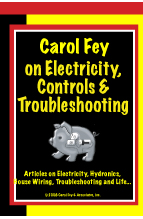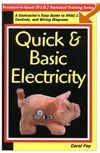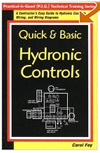by Carol Fey
Rule of thumb: If you can’t find it in 15 minutes, it’s junk.
I was traveling with Steve, a plumbing distributor rep. As we
pulled into the yard of Aesop’s Plumbing and Heating, there
was an all-too-common view — junk everywhere.
Most visible were the old vehicles. There was a 1972 Dodge
Tradesman van with an oddly shaped customized window in the
side door, license plates 1984. All visible tires were flat.
There was a 1980 Volkswagon Rabbit, with the label “diesel”
hanging crookedly under the hatchback window. And there was
a 1984 Toyota Camry, 1989 plates, front-end smashed, hood
jutting into the air.
Anybody’s yard might have old cars and trucks. But a plumbing
yard has more interesting items: a vintage Maytag washer;
an ancient boiler, rusting pipe attached; an aqua blue toilet
and matching sink, 1950s vintage, I’d guess; any number of
water heaters, rusting; a large bird cage, the door hanging
open, no bird.
“Why do they do this?” I sighed to Steve.
“Do what?” he asked.
“Leave junk everywhere. It makes the whole industry look bad.”
“That’s not junk, Carol,” he said. “That’s spare parts.”
Ah, yes. I knew that. One person’s junk is another’s spare
parts.
We all have it. Whether you call it spare parts or junk, I
bet there’s some — maybe a lot — around your place, too.
The problem with junk when you’re in business (you are in
the plumbing and heating business, aren’t you?) is that it
costs you. It might be costing you money, but there’s also
the cost of the space to store your junk. Even if it’s your
side yard, you could be using that for something else. There’s
intangible costs of moving around it, or moving it to get
to something else.
At the very least, it costs you in image, and image is an
important part of being in business, right? Even if it’s inside
where the public doesn’t see, the junk is still there for
you and your employees to deal with.
But I’m pretty sure that yours, like mine, isn’t junk, but
rather “spare parts.” It’s going to come in handy some day.
If we get rid of it today, tomorrow we’ll be sorry. But really,
what is the difference between spare parts and junk?
Junk Collector
My father was a collector of spare parts. He worked for the
electric utility. During the 1960s, the company was shutting
down a number of small local power plants, including those
along the Scioto and Olentangy rivers. After the shutdown,
employees could take home whatever was left. To Dad, every
nut and bolt had a potential use. But most items were bigger
than that. The back yard filled up. The basement filled up.
For a long time there was a heated debate at home about what
these things were. Mom insisted, “This bringing home junk
and more junk has got to stop.” Dad maintained that it was
all parts he had a use for. They compromised. If it was labeled
and neatly stored on a shelf, either in the shed or in the
basement, it was parts. Otherwise it was junk and had to go.
Dad lovingly labeled it all, including paint cans with the
letters “MT”—empty. And I agree. There are times when an empty
paint can is just what you need, provided you can find it.
But I think Mom was on to something. Perhaps it’s the labeling
and organized storage that makes the difference between junk
and spare parts. Or at least it’s the knowing where the items
are. If you can put your hands on what you’re looking for
in 15 minutes or less, it’s parts. Much more rummaging that
that, it’s junk.
Not long ago. I was hanging around the A&A Trading Post,
one of the best hardware stores ever. It’s one of those places
with the sloping and creaking wooden floors that make you
expect an old geezer in overalls to come shuffling out from
some corner and ask, “Whatcha lookin’ for?” The A&A has
everything, and it has a crew of old geezers that knows exactly
where to find that odd part you need for any job, carpentry,
plumbing or electrical. There are a lot of old-guy customers,
too.
Here’s what I overheard.
Old-guy customer: “Why that’s highway robbery! You want $1.19
for that fastener? Why, I got four just like it at home that
didn’t cost me near that.”
Old-guy employee: “I got no doubt you do. But you don’t know
where yours are, do you?”
Old-guy customer, taking the fastener: “All right, ya got
me there. Gimme that darn thing. I’ll pay your thieving price.”
Comes In Handy
Here’s another way to look at this. This past summer I stopped
at the settlement of Wiseman, Alaska (pop. 30), on my way
to the Arctic Ocean. Resident Jack Murphy gave us a guided
tour. He’s lived there since he was 5 years old. There are
only a handful of year-round residents, including Jack’s mother
who lives in her own cabin and chops her own wood for heat.
Jack’s two grown children moved to the big city — Fairbanks
(pop. 30,000) — which is good, Jack said humorously, because
his one-room cabin wasn’t big enough for all of them.
Jack doesn’t mind giving walking tours of the settlement.
Even though there are streets, they’re more like one-way trails,
mostly gravel with potholes. The houses are small, and feel
as if they’re all sharing one huge meadow for a yard. The
summer grass and small vegetable gardens go on and on without
the division of any fences.
Jack was proud of the fact that he’s one of the few year-round
residents, and said that about half the houses — all small
log cabins, some ancient and sagging, a few obviously bolt
upright and brand new — were owned by summer people. Who would
have thought, summer places above the Arctic Circle!
Now here’s the important part. Jack said with a chuckle that
the way you could tell a year-round home from a summer place
is the junk around the house. What do you think? Which place
has the junk?
The year-round residences are all surrounded by what looks
like junk, but is really spare parts.
In the summer, you can take the gravel Dalton Highway 275
miles to the nearest major city of Fairbanks. The rest of
the year, there’s no way in or out of Wiseman except by snowmobile,
dog sled or show shoes. So self-sufficiency is essential.
And that means spare parts, even if they look like a yard
full of junk.
Here’s another interesting Alaskan take on spare parts. In
the three years it took to build the Alaska pipeline, they
had more than $175 million in spare parts, enough to strain
the supply capabilities of companies like Caterpillar. You
probably don’t have that much tied up, but you might want
to take inventory of your spare parts. And if you can’t find
that part within 15 minutes or so, you might want to inventory
your “junk.”
|




